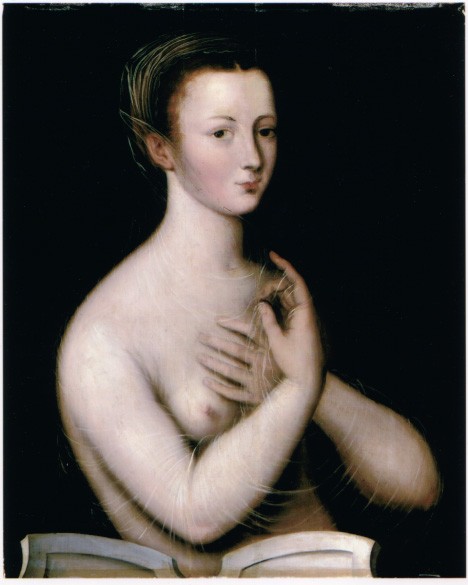School of Fontainebleau
Circa 1590Sabina Poppea
Oil on panel: 25 x 20 1/2 in. 63.5 x 52 cm.
Jean-Pierre Cuzin, Ancien conservateur en chef du département des peintures du Louvre,, has confirmed that the present painting is one of several versions of the subject produced by the School of Fontainebleau in the late 16th.century.
This alluring image celebrates two of the most intriguing and influential ladies in history. While the subject traditionally alludes to the Roman mistress and second wife of the Emperor Nero, the physical likeness suggests it represents a portrait of the mistress of Henry IV of France, Gabrielle d’Estrees. This identification is confirmed by comparison with the painting of Gabrielle and one of her sisters in the bath, now in the Louvre. It would perfect sense to represent the infamous Poppea, who negotiated her way into the imperial bed through merciless intrigues by using the image of the French royal mistress, albeit a lady of considerable more virtue and finesse, both as a politician and diplomat.
Accounts of Poppea’s trajectory to Empress, or Augusta, are many and varied, and include references by authors such as Tacitus and Suetonius. It seems probable that her father was “in trade” in the tiling business, but that her mother came from a more distinguished family. Their possible home was the House of Menander in Pompeii. After marriage to a member of the Praetorian Guard, then to Otho, a close friend of Nero, Poppea reputedly manoeuvred her way into the Emperor’s affections and subsequently married him in 62 AD, Nero having sent Otho away and divorced his first wife and step-sister Claudia Octavia. Accounts of Poppea’s activity as Empress vary between benign and destructive, but the manner of her death is more precise. Having enraged her husband with criticism, he kicked her pregnant belly or jumped on it and killed her. Imperial remorse resulted in a state funeral at which gargantuan amounts of Arabian incense were burned. The empress survives in culture as the subject of Monteverdi’s opera L’Incoronazione di Poppea, and Handel’s Aggrippina.
By contrast the career of Gabrielle d’Estrees was more straightforward. After Henry IV succumbed to her charms in 1590 she assumed the role of political and diplomatic advisor with access to his council through the gold key. Her smart achievement as a Catholic was persuading her lover the king to realise that “Paris is well worth a Mass” and forsake his native religion to adopt Catholicism. Later, together with her Protestant sister Catherine, she used diplomatic gifts to bring both religious sides together and negotiate the Edict of Nantes which allowed Protestants freedom of worship. The famous portrait in the Louvre where Gabrielle sits with her sister holding the king’s coronation ring shows a sensual side with huge erotic charge. This sensuality is transferred to our portrait where the graceful profile of her body is discreetly blurred by a veil. Although viewed from a different angle, the royal mistress’s features have been sublimated into those of the infamous Poppea.

